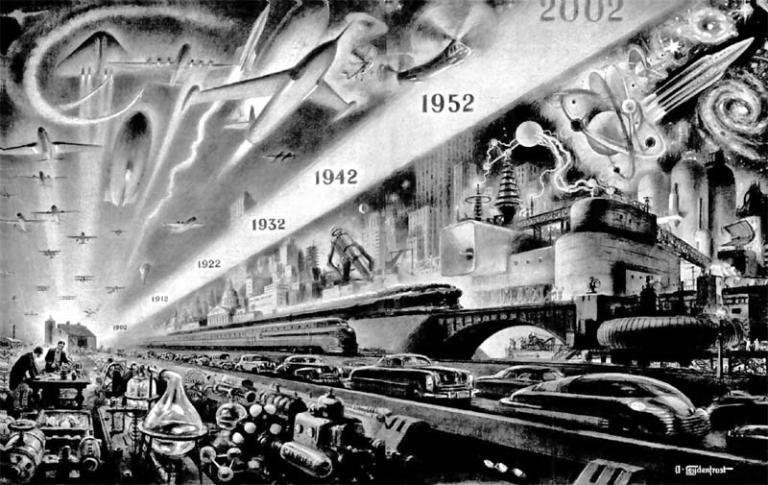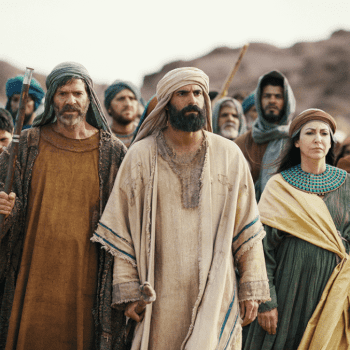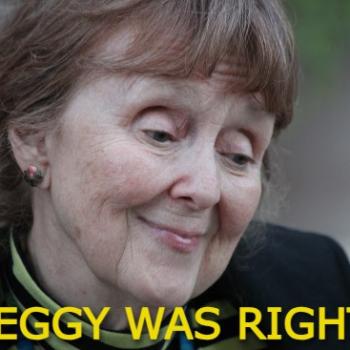Religion Dispatches is a reliable site for smart commentary, and Jay Michaelson seems like an engaging fellow, but his latest RD article — “Why I’m Grateful for 2012, The Rapture, and Other Millennial Delusions” — is an unholy mess.
Michaelson gets his eschatology scrambled, reversing pre- and post-millennialism, and thereby also garbling American history beyond recognition. A big mess.
The article gets off to a promising start, with a helpful general overview of millennialism and millennial fervor:
Millennialism … is the general term for the belief — religious or secular, but usually religious — that a massive global transformation is imminent, from Christ’s Second Coming (the “millennium” refers not to the turn of 1999–2000 but to the thousand years during which Christ will reign on Earth) to the messianism of a Sabbetai Sevi or David Koresh to, well, 2012.
We err if we suppose that all millennialists march around with banners proclaiming that the end of the world is nigh. As scholars have rightly pointed out, millennialist thinking is found in Islamism, Marxism, and many other political theories which inspire real action in the real world. Not all millennialists are quietists; on the contrary, like the Aum Shinrikyo cult in Japan, which unleashed Sarin gas in the Tokyo subways, many take matters into their own hands, often with tragic results.
One of the most important, if subtle, transformations in American public life, for example, was the shift in evangelical thinking from post-millennialism to pre-millennialism, which took place gradually from the end of the 19th century to the end of the 20th. …
So far so good. But the next sentence takes a wrong turn and Michaelson picks up speed in the wrong direction:
Post-millennialists believe that there’s not much we can do to effect when Christ returns; the world will just keep getting worse and worse, and eventually He’ll come and rescue us. The millennium comes after he does. Pre-millennialists, on the other hand, believe that we have to prepare the way. We must reform our society as the kingdom of God on Earth, and only then can Christ return. In this view, the millennium comes first.
No. That’s precisely backwards, and Michaelson’s inversion turns the rest of his religious history on its head as well.
Granted, this pre- and post- terminology is confusing, so let’s try to sort this out.
 Before clarifying the difference between these pre-mill and post-mill perspectives, we should note the important context here that these are categories of millennialist Christianity, but that millennialism itself is not a majority view within Christianity. The binary labels of pre- and post- can mislead us into thinking that all Christians must be one or the other of these things, when in reality most Christians are neither.
Before clarifying the difference between these pre-mill and post-mill perspectives, we should note the important context here that these are categories of millennialist Christianity, but that millennialism itself is not a majority view within Christianity. The binary labels of pre- and post- can mislead us into thinking that all Christians must be one or the other of these things, when in reality most Christians are neither.
The pre- and post- prefixes there do indeed refer to the idea of Christ’s return. And the “-millennial” part does indeed refer to Christ’s thousand-year reign, meaning the idea of perfect and enduring earthly justice. So for a pre-millennial believer, Christ’s return must come before any hope for perfect justice. But for a post-millennial believer, the idea is to bring about perfect justice here on earth, thereby inviting Christ’s return after that happens to assume his millennial reign.
It’s the pre-mill types who “believe that there’s not much we can do” and that “the world will just keep getting worse and worse.” And it’s the post-mill types who feel that social progress is mandatory and inexorable. Premillennialism is deeply pessimistic about human history, which they regard as a long slouch toward Armageddon. Postmillennialism is audaciously optimistic about human history, viewing it as a steady march ever closer to perfection.
Get that backwards, as Michaelson does, and you’ll wind up mangling American history, as Michaelson also does:
For much of the 19th and 20th centuries, most American evangelicals were post-millennialist, and as such stayed out of politics. America was going to hell, and the best thing for Christians to do is hunker down and wait it out.
That first sentence is wrong in several ways. Many American evangelicals were, in fact, postmillennialist in the 19th century. But not in most of the 20th. And precisely because those 19th-century evangelicals were postmillennialist, they did not at all believe that “America was going to Hell.” Nor were they “hunkered down.”
In the 19th century, American evangelicals wanted to change the world. And they did. Their efforts were vast in scope and enormously ambitious. Just consider a few of the causes they undertook and the prolonged dedication they applied to them: the abolition of slavery; women’s suffrage; temperance; the global missionary movement.
These were massive undertakings pursued by American evangelicals confident that they were commanded by God to usher in a millennial reign of divine perfection. That is what postmillennialism looks like. It’s optimistic, audacious, aggressive and (over)confident.
The best short introduction and explanation of this postmillennial vision — particularly in its 19th-century, evangelical, American formulation — is Julia Ward Howe’s “Battle Hymn of the Republic“:
He has sounded forth the trumpet that shall never call retreat;
He is sifting out the hearts of men before His judgment seat:
Oh, be swift, my soul, to answer Him! be jubilant, my feet!
Our God is marching on.
This is an inspiring vision. The optimism is compelling and attractive, and it’s easy to understand why this postmillennial fervor was once so popular.
But it couldn’t last, because this idea of inexorable progress toward perfect justice doesn’t correspond with actual history and human experience. The soaring ambition of postmillennialism came crashing back down to earth in the early decades of the 20th century. (One of my favorite theologians, Reinhold Niebuhr, was in many ways the coroner who conducted the autopsy on American postmillennialism, detailing the many causes of its death.)
Postmillennialist fervor faded due to its failures — such as the horrors of a “war to end all war,” that didn’t end all war, but left a broken generation scattered across Europe. And it faded due to its successes, such as Prohibition.
The Temperance movement was postmillennial and anything but temperate. It had been shaped by abolitionism and that had become its model for social change. Social ills weren’t something to be merely amended or corrected, they were to be abolished. This was an essential part of building the kingdom of God here on earth to usher in Christ’s return and millennial reign. But Prohibition didn’t turn out to be the conclusive triumph the Temperance movement had imagined, further chastening postmillennial fervor.
Around the same time, American Christianity was itself going through a kind of civil war in the fundamentalist-modernist controversy that was splitting denominations, congregations and seminaries. Southern Christianity — with its otherworldly religion shaped by centuries of slaveholding — reasserted itself to take sides against the worldly threat posed by biblical criticism, evolution and 20th-century science. This otherworldliness got a big boost from the Scofield Bible and the viral spread of pessimistic premillennialism.
Postmillennialism, like William Jennings Bryan, had gotten its chances and come up short. And so in the early decades of the 20th century, American evangelicals retreated into otherworldly religion and premillennial pessimism. They retreated from denominations and seminaries, from schools and statehouses and public life. And that’s where the long decades of “hunker down and wait it out” began. Evangelicals were more concerned with Heaven and Hell than with this world in general, or with America or politics in particular.
How that changed — how these pessimistic, otherworldly, premillennialist evangelicals were transformed into the engaged political activists of the religious right — is a complicated story. It involves the rise of new forms of postmillennialist Christianity — such as the dominion theology of the right-wing Reconstructionists and of many Pentecostal churches. And it involves a very strange evolution in premillennialism from the pessimistic quietism of Scofield and Hal Lindsey into the aggressive, ambitious political movement envisioned by post-Lindsey premillenialists like Jerry Falwell and our friend Tim LaHaye.
(It also involves cynical exploitation, crassly partisan politics, Nixon’s Southern Strategy, Brown v. the Board of Education, fear of hippies, and Jerry Falwell’s racist meltdown in the wake of the Bob Jones decision. But here we’re mainly focused on eschatology.)
The internal contradictions of these activist premillennialists fascinate me. These are people who believe the world is destined to get worse and worse, sliding inevitably toward cataclysm and tribulation. And yet they also seem confident that political change is possible.
That’s what I’m struggling to understand. Hal Lindsey and Jesus Freaks like Larry Norman were premillennialists who believed that our only hope was in the Rapture and the Second Coming of Jesus. No political change was possible or meaningful until then, and it was expected to happen at any moment anyway, so political activism and social justice were of no consequence to them. If you accept their premise, then their political quietism and retreat from society is a logical conclusion.
But Tim LaHaye and many other prominent figures of the religious right accept those same premises and come to very different conclusions. Why? Why did so many late-20th-century premillennialists start acting like they were postmillennial dominionists?
I understand LaHaye’s eschatology. And I understand LaHaye’s political ideology. But I do not understand how Tim LaHaye reconciles his eschatology and his political ideology. It seems just as mixed up and confused as Jay Michaelson’s article.
















